Highlights July 1966
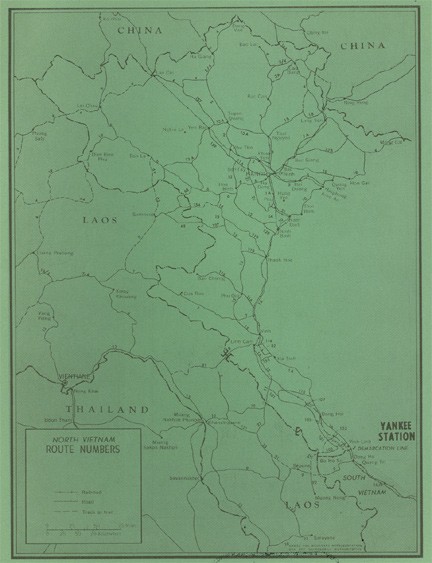
Throughout July 1966 steady pressure from the Navy continued to inflict injuries upon the Viet Cong. Six thousand naval air combat sorties were flown in North and South Vietnam during this month -- the 18th -- of sustained operations in Southeast Asia. On 16 July, DECKHOUSE TWO, another SEVENTH Fleet amphibious operation, was conducted in the Dong Ha area by the Ready Amphibious Force. Throughout the month other SEVENTH Fleet ships bombarded the enemy with more than 20,000 rounds of ammunition and 8,000 rockets. At the same time the coastal and river patrol forces under Commander Naval Forces Vietnam boarded 24,000 native junks and sampans in a continuing effort to deny Vietnam's coastal waters and rivers to the enemy. These combat operations were massive and yielded impressive results.
Task Force 77 aircraft carriers exerted an increased offensive against POL transshipment and storage areas in addition to routine interdictions of lines of communication in North and South Vietnam. These strikes were precise and resulted in an estimated 57% destruction of North Vietnam's POL capacity as of 22 July. An effect of these and earlier raids was reflected in the absence of any tanker arrivals in North Vietnam during the month. Air attacks also destroyed five North Vietnamese PT boats; and during one week's operations (17-23 July) carrier planes destroyed fifty trucks.
Naval aircraft engaged North Vietnamese MIG-17s on two occasions. In total, eight MIG-17s, four F-4Bs and three F-8Es were involved. The two aerial engagements resulted in one MIG-17 shot down and one F-8E also lost. Including this F-8E, Navy losses for the month were 13 aircraft and seven aircrewmen, bringing the total Navy aircraft lost during the war to 183 and total pilots and crewmen to 140.
SAR forces rescued eight Navy fliers including LTJG Dieter DENGLER who had escaped from a Communist prison camp. DENGLER was shot down in February, spent five months as a prisoner of the Pathet Lao in Laos. and had been evading the enemy for 23 days when he was recovered by a USAF helo.
Amphibious operation, DECKHOUSE TWO, was executed 15-17 July to permit the SEVENTH Fleet's Special Landing Force and the entire Amphibious Ready Group to support the Army's Operation HASTINGS in Quang Tri Province. Together, the two operations accounted for 769 confirmed dead (NMCC lists 818) and 926 probable dead, against Marine losses of 125 KIA.
In July, twenty-four Naval gunfire support ships fired a daily average of 927 rounds. They destroyed 2,322 structures, damaged 3,027 buildings and sank or damaged 230 junks and sampans. An outstanding example of this kind of support was provided by WHITE RIVER (LSMR 536) which completed her initial tour in Vietnam on 28 July. During four months in Southeast Asia, WHITE RIVER fired 9,437 rockets, 1,036 5"/38 projectiles, and 9,138 rounds of 40 millimeter ammunition. More than 2,000 structures were destroyed. U.S. coastal forces (MARKET TIME) on daily patrols averaged 5 DERs, 5 MSOs, 3 MSCs, 16 WPBs, 29 PCFs, and 1 LST, detaining 123 suspect junks and 1,906 individuals. Typical of MARKET TIME operations was an action of 5 July when PCF 60 detected a junk evading to the beach near Song Cau. Ignoring warning shots and sirens, the junk was beached and the occupants fled ashore as PCF 60 destroyed the abandoned junk with mortar fire.
Sixteen additional PCFs arrived in country during July to bring the total number of SWIFTs to 70 PACVs, after evaluation, were being modified with more armament. Also in July, the Harbor Defense unit at Qui Nhon became fully operational, and harbor defense forces elsewhere were increased, permitting limited operations.
COMNAVFOR Vietnam's riverine Navy, the River Patrol, (GAME WARDEN) consisting of 71 PBRs, 12 MSBs, the SEAL Team, and two helicopter fire teams from TORTUGA (LSD 26), focused operations in the Mekong Delta and the Rung Sat Special Zone. Results included 18 confirmed enemy killed (38 estimated), 26 sampans and 36 structures destroyed. u.S. Naval casualties were three men wounded. The significant result was the growing interruption of the enemy's use of the waterways in this delta stronghold. Highlights of the river force operations included actions by PBRs 103, 105, 109, and 110 on the Cau Tieu River near My Tho on the night of 23 July. There, accurate intelligence and aggressive tactics led to the interception and sinking of a hostile junk attempting a river crossing. At least seven enemy were killed.
Three SEAL teams in the Rung Sat Special Zone launched their largest operation to date on 27 July near Can Gio village. The teams discovered a hastily evacuated camp and destroyed or captured the buildings, two carbines, 500 rounds of small arms ammunition, plus numerous intelligence documents.
Helicopter fire team operations included 17 reaction missions in support of PBR patrols and 43 armed reconnaissance flights. On one mission in the Long Toan Zone, helicopters celebrated the Fourth of July by pouncing on a large number of sampans. One of these exploded and disintegrated. Six others were damaged.
The careful and patient indoctrination by COMNAVFORV's Naval Advisory Group brought improvements in Vietnamese Naval operations, officer leadership, and maintenance. For example, the engineering crew of PGM 601 worked throughout the night to replace a main engine camshaft. A few months ago, this PGM would have been out of action waiting for shipyard repair.
The South Vietnamese Navy maintained on patrol a daily average of 20 craft from the Sea Force, 89 from the River Force and 152 from the Coastal Force. Highlights in their operations included the activities of the Coastal Group junks in numerous patrol, blocking and small-scale amphibious operations. For example, on 27 July two platoons from Coastal Group 11 landed near Xam Sao to aid 20 Popular Force troops under attack by the Viet Cong. They routed the Viet Cong, killed seven, captured an automatic rifle, a bolt action rifle, ten grenades, and three anti-tank rockets, at the cost of two men killed.
One of many effective River Force operations came on 12 July when River Assault Group (RAG) 22 located and destroyed three enemy base camps in the Rung Sat Special Zone. On the following day, 13 boats from RAGs 21 and 27, with embarked South Vietnamese troops, undertook an inland amphibious operation 25 miles southeast of Vinh Long. One hundred fifty-five Viet Cong were killed, and war supplies in quantity were captured. Three men were lost.
Vital to the support of all combat operations were the "beans and bullets" supplied by MSTS and SERVPAC. MSTS transported 887,000 measurement tons and lifted 13,583 troops to and between ports in Vietnam. Service Squadron THREE in the area conducted 656 underway replenishments and 69 vertical replenishments during the month. This busy squadron supplied the 75,000 men and 207 ships of the SEVENTH Fleet, as well as the far flung units assigned to MARKET TIME and GAME WARDEN patrols.
Another SERVPAC command, the Naval Support Activity, Danang, was selected by the Joint Transportation Board as the Navy unit to receive the National Defense Transportation Association Annual Award for best performing transportation functions under combat conditions. In addition to transportation, NSA Danang continued to provide a variety of other logistic and housekeeping services to American forces in the northern portion of the country.
Critical shortages continued for UH-1E aircraft and 5"/38 AAC projectiles. Survival radios were removed from the Flag Pole list on 29 July. During the month new procedures were introduced by the JCS to reduce to sixty days the time for moving selected air munitions to Southeast Asia. Included were such naval items as MK 81 and 82 bombs, MK 24 flares, 2.75" rockets, 5" Zuni rockets, MK 77 fire bombs, and 20mm ammunition for the MK 12 gun.
U.S. commands conducted extensive civic action efforts designed to help Vietnamese authorities win the allegiance of more and more citizens. The Navy's SEABEEs, chaplains, medical corpsmen and doctors assigned to the THIRD Marine Force, were especially active, as was the Naval Support Activity, Danang.
The THIRD Marine Amphibious Force benefitted from the civic action by naval and marine personnel by receiving an increasing flow of intelligence on the enemy from the civilian population. The Marines conducted eight operations of battalion size or larger, resulting in 1,039 enemy regulars killed. Counterguerrilla operations in July amounted to 12,454, the third highest figure of the war; but more important, there were more contacts (1,457) and more of the guerrilla enemy killed (538) than in any previous month. Helicopter squadrons set a new record of over 40,000 sorties.
Political and religious unrest in the Republic of South Vietnam declined noticeably as preparations advanced for the general legislative elections of September. Five generals responsible for the political disturbances in the Danang-Hue area from 13-23 May received short prison terms, after which all were slated for discharge or retirement.
As July passed into August, seapower continued its major role in the fight against the Viet Cong and their North Vietnamese allies. CONSTELLATION and RANGER were at YANKEE Station supported by CHICAGO and ST. PAUL. INTREPID was at DIXIE, but soon to move north to participate in three carrier operations from YANKEE. PRINCETON was the LPH; and in the wings at Subic were ROOSEVELT, ORISKANY, IWO JIMA, assault ships, destroyers and submarines. COMSEVENTHFLT, embarked in OKLAHOMA CITY was at Yokosuka.
The Navy's attacks, whether they came from carrier decks, the Ready Amphibious Force, gunfire support ships, or units assigned to river and coastal patrols, continued to be an essential part of the national strategy of seeking and destroying a persistent and often elusive enemy.
On 1 July, HANCOCK and CONSTELLATION were at YANKEE Station, and ORISKANY was at DIXIE. Aircraft from YANKEE CVA's hit POL storage areas in the Hanoi/Haiphong complex for the third consecutive day. At Dong Nham, 13 miles northwest of Haiphong, 15 naval aircraft destroyed seven POL tanks and four support buildings.
On the same day, an F-4 BARCAP sighted three high speed surface contacts closing three U.S. destroyers on SAR station in the Gulf of Tonkin. The northern SAR commander in COONTZ (DLG 9) was notified, and air support was requested. The targets, identified as PT boats, were taken under attack by two F-4s, four A-4s and two A-6s from CONSTELLATION. All boats were sunk. One F-4 was damaged, but all planes returned safely to base.
The next major strike was conducted on 7 July when the Haiphong storage area was struck once again by naval aircraft. A large part of the pumping and storage capacity of the complex was destroyed this time, with pilots reporting dense black smoke rising to 20,000 feet and secondary explosions. On the same day, two A-4Cs from CONSTELLATION once more attacked enemy PT boats. There were four of them -- all camouflaged -- cruising about six miles south of the Hon Gay Naval Base. After other jets were diverted to the scene, two PTs were sunk, one was left beached and burning, and the fourth was severely damaged. This left the North Vietnamese with an estimated inventory of five PT boats.
On 8 July, ORISKANY relieved HANCOCK on YANKEE Station and INTREPID relieved ORISKANY on DIXIE Station.
On 9 July, a major highway bridge was attacked, and a strike on the Thanh Hoa POL storage areas produced a large secondary explosion and residual oil fires.
On the 12th successful attacks were conducted once more on the Dong Nham and Haiphong POL areas.
On 13 July, the Co Trai highway bridge was attacked for the second time in two days. It was hit but not downed. An IRON HAND element conducted a successful SHRIKE and bombing attack on a SAM site in the vicinity of the bridge. Two F-4s making a visual bomb-damage-assessment run were attacked by two MIG-17s. While maneuvering for attack on the MIGs, the F-4s were fired upon by two other MIGs. Two more F-4s, upon hearing of the fight, proceeded to the engagement, obtained a firing position, and downed one MIG with a SIDEWINDER. The remaining MIGs escaped into the clouds. The next day, three F-8s engaged two MIG-17s south of Hanoi. No aircraft were downed, but one of the F-8s sustained damage from MIG gunfire. The pilot subsequently made a successful ejection when unable to refuel due to battle damage. He was picked up by helo.
On the 14th, RANGER relieved CONSTELLATION at YANKEE Station.
During the third week 50 trucks were destroyed or damaged, and damage or destruction was achieved on bridges at Lan Tra, Quang Khuyen, Lan Ban, Phu Quat and Hung Long. Attacks were conducted against fixed military and logistic targets at the Kenh Gia, Ben Thuy and Dam Ding transshipment points. Additionally, attacks on the Qui Vinh and Phy Ly railroad yards, Ke Nheo barracks area and Dong Liet supply area netted damage or destruction of many lucrative targets.
Air operations on the 19th were hampered by unsatisfactory flying weather in the wake of Typhoon MAMIE. This lost time was made up in the next four days when RANGER and ORISKANY Air Wings hit hard at land and sea lines of communication in addition to continuing their attacks on POL areas.
On 24 July, Tropical Storm ORA was upgraded to a typhoon and began to threaten the YANKEE Station area; nevertheless, attacks on POL targets continued with excellent results in all cases.
On the 25th, what is believed to have been the first attempted low altitude intercept of U.S. aircraft over the Gulf of Tonkin by North Vietnamese aircraft occurred when a contact evaluated as a MIG-2l closed an EC-121. The EC-121 headed for a destroyer on SAR station, and F-4s were vectored for intercept. The bogey, however, faded to the north and contact was lost. The greater portion of the day's scheduled air operations was cancelled as Typhoon ORA dominated the weather picture, causing heavy seas. RANGER and ORISKANY were forced to conduct storm evasion maneuvers, but even so, still engaged in reduced flight operations.
While SA-2 missile firings occurred all during the month, an unusual situation occurred on the 28th when at least six SA-2s were fired from two SAM sites within three minutes, apparently at three A-4s in the area. One A-4 did not return from the mission, although loss from a missile was not confirmed.
CONSTELLATION returned to YANKEE Station on the 29th, relieving ORISKANY. As the month ended, air attacks continued to be directed principally against POL facilities including a spectacular strike in the Vinh area which resulted in four fireballs, large secondary fires and dense smoke. On 30 July, the CHICOM freighter NAN HAl fired upon a CONSTELLATION F-4 making an identification pass near the vessel. The fire was not returned. INTREPID remained on DIXIE Station, providing approximately 90 attack and interdiction strikes per day in support of operations in South Vietnam.
During July, photo reconnaissance aircraft flew more than 160 BLUE TREE photo sorties in North Vietnam and more than 10 YANKEE TEAM photo sorties in Laos. Continuing efforts, however, to secure selected mosaic and cartographic photo mapping coverage of Laos (COWBOY 1) again produced no appreciable usable film coverage.
NAVY ATTACK SORTIES
| NVN | SVN | LAOS | TOTAL | |
| MARCH | 1923 | 3474 | 1247 | 6644 |
| APRIL | 2780 | 3184 | 917 | 6881 |
| MAY | 2568 | 2810 | 561 | 5939 |
| JUNE | 3078 | 2597 | 118 | 5793 |
| JULY | 3416 | 2607 | 0 | 6023 |
NAVY COMBAT AIRCRAFT/AIRCREW LOSSES IN SEASIA
MONTH |
AIRCRAFT |
AIRCREW |
AIRCREW |
| ALL 1964 | 4 |
2 |
2 |
| ALL 1965 | 101 |
80 |
46 |
| JAN 1966 | 6 |
5 |
5 |
| FEB 1966 | 9 |
10 |
2 |
| MAR 1966 | 11 |
11 |
3 |
| APR 1966 | 21 |
14 |
15 |
| MAY 1966 | 9 |
2 |
8 |
| JUN 1966 | 9 |
9 |
4 |
| JUL 1966 | 13 |
7 |
6 |
| TOTAL | 183 |
140 |
91 |
SUMMARY OF U.S. AND NVN AIR ENGAGEMENTS
| DATE/ TIME |
ENGAGEMENTS |
NUMBER & TYPE |
KILLS
|
|||
(HANOI) |
U.S. |
NVN |
U.S. |
NVN |
BY US |
BY NVN |
| 7 JULY 1515 |
2 F-105 |
2 MIG-21 |
0 |
2 AAM |
0 |
0 |
| 11 JULY 1407 |
4 F-105 |
2 MIG-21 |
0 |
2 AAM |
0 |
0 |
13 JULY |
4 F-4B |
6 MIG-17 |
2 SPARROW |
CANNONUNGUIDED |
1 MIG-17 |
0 |
14 JULY |
4 F-4C |
2 MIG-21 |
SIDWINDER |
0 |
2 MIG-21 |
0 |
14 JULY |
3 F-8E |
2 MIG-17 |
2 SIDWINDER |
CANNON |
0 |
1 F-8E |
TOTAL AIRCRAFT LOSSES IN MIG AIR ENGAGEMENTS THROUGH JULY '66:
CONFIRMED |
PROBABLE |
||
U.S. |
-- |
2 F-105 |
1 A1E |
2 F-8E |
|||
|
|
|
|
NVN |
-- |
15 MIG-17 |
|
3 MIG-21 |
SAR IN SOUTHEAST ASIA
On 4 July, an A-4C from HANCOCK was hit while conducting a night bombing attack on a brldge in NVN. The pilot ejected from his burning aircraft over the Gulf of Tonkin, suffering a broken arm. A HANCOCK UH-2 helo, however, made a successful night rescue and returned him aboard. A
The pilot of an A-4E from CONSTELLATIONspent the night of 4 July in his life raft after ejecting off the coast of North Vietnam. He was rescued the following morning by an SH-3 SAR helo and taken to USS CHICAGO (CG 11). The helo was escortedby an A-6A aircraft which suppressed small arms and mortar harassment during the rescue operation. B
Following a Haiphong POL attack, on 7 July, the pilot of a HANCOCK A-4C left his damaged aircraft over the water 25 miles SE of Haiphong and was successfully picked up by an SH-3 SAR helo which returned him to HANCOCK. C
On 12 July, two A-1H RESCAP aircraft escorted an SH-3 SAR helo to a successful pick-up of an F-8E pilot from ORISKANY downed 20 miles NE of Haiphong. The A-1H aircraft utilized rockets to suppress 37mm AA fire during the rescue. D
The pilot of a damaged ORISKANY F-8E aircraft attempted to divert to Danang for an emergency landing on 14 July, but had to eject over water prior to reaching Danang. He was rescued by a USAF UH-34 helo. E
A USAF F-4C was downed by AA fire while conducting an armed recce mission just north of the DMZ on 17 July. The pilot and RIO ejected offshore into the Gulf of Tonkin. Marine helos participating in DECKHOUSE TWO diverted to the SAR scene to effect the rescue and took the pilots to PRINCETON for medical examination. During the rescue, the Marine helos were under artillery fire from the beach, and NVN junks were seen approaching the area. F
On 20 July, a Navy A-1H pilot, LTJG Dieter DENGLER was rescued by an Air Force helo about 20 miles north of the DMZ in North Vietnam. The Navy pilot had been declared MIA since 1 February 1966 when his A-1H was downed during a bombing run. (SAR at that time had located the downed aircraft but had found no trace of the pilot.) The pilot had spent five months in a communist prison camp but escaped and evaded the enemy for 23 days prior to his rescue. G
On 21 July, a Marine A-4E was hit by ground fire while on a bombing run on a target in South Vietnam. The pilot ejected and was picked up by a Marine he10 from USS PRINCETON (LPH 5). H
The pilot of an ORISKANY A-4E conducting an attack on the Vinh POL target on 23 July reported that he had been hit and was bleeding badly. He was able to head his damaged aircraft to the vicinity of the SAR DD, USS REEVES (DLG 24), where he ejected. REEVES's helo was launched for the rescue, but a motor whale boat recovery was made because of the pilot's serious injuries. An SH-3 helo with a doctor on board evacuated the pilot from REEVES to ORISKANY. I
On 24 July, a RANGER A-4E pilot was rescued from the Gulf of Tonkin by an SH-3 SAR helo and returned to RANGER uninjured after his aircraft received critical damage on an armed recce mission over NVN. J
(NOTE: Lettered incidents correspond to positions of SARs on the following chart.)
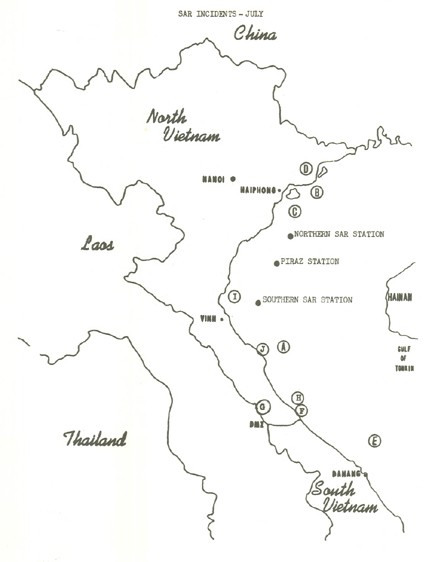
Amphibious Operations
During the early part of July, intelligence reports reflected a large enemy force building up just south of the DMZ in Quang Tri Province near the coast. Information concerning this buildup was linked with reports that a NVA/VC attack on the First Corps Tactical Zone was imminent. In response to this intelligence, CG III MAF launched Operation HASTINGS on 7 July as a combat reconnaissance operation northwest of Quang Tri City. On the same day, COMUSMACV requested that the ARG/SLF be stationed off the I CTZ littoral in an alert status for amphibious support. The ARG/SLF was made available for the period 16-24 July.
DECKHOUSE TWO
Operation DECKHOUSE II was planned as an amphibious assaultwith BLT 3/5 choppingto CG III MAF for participation in Operation HASTINGS once the landing force was firmly established ashore. Forces assigned were as follows:
| CATF | CTG 76.5 |
USS PRINCETON (LPH 5)
USS ALAMO (LSD 33)
USS PICKAWAY (APA 222)
USS COOK (APD 130)
| CLF | CTG 79.5 |
BLT 3/5
HMM363
DET VMO-6
| NGFS | CTG 70.8 |
USS OKLAHOMACITY (CLG 5)
USS LOFBERG (DD 759)
USS WHITE RIVER (LSMR 536)
CAP |
CTF 77 |
LOGISTICS |
CTF 73 |
The Amphibious Ready Group ships PRINCETON, ALAMO, PICKAWAY, COOK, LOFBERG and WHITE RIVER departed Danang on 15 July, under conditions of radio silence and darkened ship, sailing for the mouth of the Song Thach Han. COOK, with UDT embarked, conducted a pre-dawn coastal reconnaissance of the landing beach (BLUE Beach), and then took station to screen the approach of the remainder of the task force. Four miles offshore, OKLAHOMA CITY stood by to provide fire support with her 6-inch guns. All ships were in position by 0500H, and the landing was conducted exactly on schedule at 160630H. In nearly perfect weather and sea conditions, the first elements of the 2,000 man Special Landing Force (BLT 3/5 and HMM-363) began landingby surface craft and helicopters at 160630H just north of the Song Thack Han, about 8 miles northeast of Dong Ha.
At H-Hour, K and I companies landed over BLUE Beach, seizing An Trung and Diem Ha Trung; no resistance was encountered. Simultaneously, L Company landed by helo about 1 1/2 miles inland in Landing Zones STORK and CROW. Again, there was no resistance.
As soon as the landing force had taken its initial objectives, Commander Landing Force moved ashore and established his command post about one-half mile inland. The amphibious phase of DECKHOUSE TWO was then terminated as planned and the SLF chopped to CG III MAF. The SLF was further assigned to the operational control of CG THIRD MARDIV for continued operations in conjunction with Task Force Delta.
The SLF BLT 3/5 and HMM-363 operated ashore until 30 July when these units completed the withdrawal phase of DECKHOUSE II and re-embarked in the Amphibious Ready Group.
Operation DECKHOUSE II resulted in no significant contact with the enemy and terminated too quickly to allow planned civic action efforts to be accomplished. Final casualties for DECKHOUSE II were for USMC: none, VC/VNA: three KIA.
Operation HASTINGS, started on 7 July as a one-battalion USMC reconnaissance operation in an area centered about 55 miles northwest of Hue, and by 15 July had expanded to include seven USMC battalions (including BLT 3/5 and HMM-363 from Operation DECKHOUSE II) and five ARVN battalions. The mission of the operation was redesignated from reconnaissance to search-and-destroy. Nine hundred and thirty-three tactical air sorties were flown in support. However, the operation took place too far inland for naval gunfire support to be
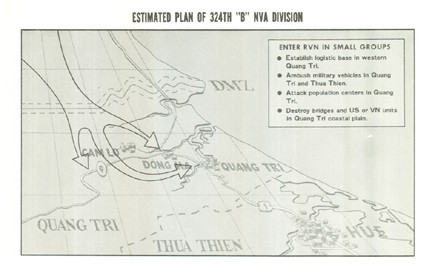
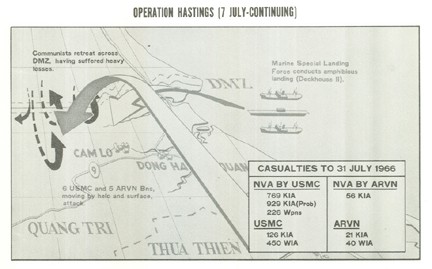
- About 5300 nautical miles from San Francisco to Pusan in Korean War.
- About 7500 nautical miles from San Francisco to An Thoi, DIXIE Station, YANKEE Station and Danang.
Increase in SEVENTH Fleet Forces Supported:
- From an average of 105 ships and 61,000 men in FY 1964 to 207 ships and 75,000 men in July 1966.
- From one to two CVAs on the line in 1964 and early 1965 to three in June 1965 and thereafter.
- From an average of 69 short tons of provisions per month transferred at sea to 92.7 tons of provisions in July 1966.
- From an average of 3,000 combat and support sorties early in the war to 8,846 in July 1966.
- From an average of 500 short tons of ammunition transfers from AEs at sea in the first months to around 10,000 tons in July 1966.
- From an average of 31 rounds per day of Navy Gunfire Support to over 900 rounds per day in July 1966. In WESTPAC, a total of 656
UNREPS and 69 VERTREPS were conducted in July. The latter consisted of 756 lifts with a total of 742.1 short tons being transferred in this manner. The UNREPS are tabulated as follows:
TYPE SHIP
|
DAY
|
NIGHT
|
AO/AOE
|
309
|
94
|
AE
|
106
|
14
|
AF/AFS
|
60
|
34
|
AKS
|
28
|
9
|
TOTAL
|
503
|
151
|
effective. Friendly forces seized or destroyed 183 rounds of 81mm ammunition, 57 cases of 7.62mm ammunition, 213 individual weapons, and 26 crew-served weapons. U.S. forces suffered 125 KIA, 445 WIA, ARVN 21 KIA, 26 WIA and inflicted on the VC/NVA 818 KIA and 13 captured.
During July, 24 gunfire support ships engaged 1,390 targets while expending nearly 20,000 rounds of ammunition and 8,000 rockets. Ships participating most repeatedly were MORTON, LOFBERG and WHITE RIVER. Reported results included 2,322 structures destroyed, 3,027 structures damaged, 230 junks and sampans reported destroyed or damaged, and 23 secondary explosions. Much additional damage was inflicted, but reports were often made that heavy foliage prevented accurate assessment. The intense and accurate fire was controlled by Army and Marine spotters on the ground and in the air.
During the first five days in July, WHITE RIVER, CLARION RIVER, BASILONE, DYESS, ROWAN, DAVIS, KRAUS, LOFBERG, ST. PAUL, WILTSIE, and JOHN A. BOLE all trained their guns either in supportof operationsNATHANHALE, WALLABYONE, HENRY CLAY, and JAY, or at selected targets in all corps and RSSZ.
On the line since June, DYESS conducted a heavy bombardment in RSSZ, prior to ARVN helicopter assault, (no U.S. troops) delivering 409 rounds in four gun salvos of mixed HC and WP ammunition against a well dug-in VC base camp consisting of supply areas, structures, and tunnel complexes located 20 miles NE of Vung Tau. Although a full damage report could not be made until after a sweep of the area by ARVN troops, the air spotter reported excellent coverage, good dispersion, and outstanding effect on all targets.
DAVIS completed her final scheduled day of NGFS in Vietnam firing at deep interdiction targets at ranges up to 22,000 yards. During 45 days of NGFS, she fired 5,008 rounds of 5"/54 and 1,085 rounds of 3"/50 for a total of 6,093 rounds of ammunition. DAVIS acquired a cumulative damage assessment to her credit of 41 VC KIA, another 24 to 30 VC probably killed, 14 WIA, 423 structures destroyed and another 489 structures damaged.
During this first week of July, WILTSIE and SAINT PAUL fired coordinated missions under the direction of the 1st Air Cavalry Division air spotting teams in support of operation HENRY CLAY which was a combined U.S. Army - ARVN search and destroy mission conducted in the Song Cau area.
During the week of 6-12 July, the NGFS force was joined by the 5"/54 rapid-fire guns of the guided missile destroyer TOWERS and the 5"/38 guns of BLACK. Operation HENRY CLAY continued, supported by SAINT PAUL with her eight-inch guns. Missions were conductedusing a mix of all types and methods of fire against various VC targets.
The week of 13-19 July saw employment of destroyers TOWERS, BLACK, LOFBERG, O'HARE, CONWAY, MORTON, the radar picket destroyer escort WILHOITE, and LSMRs WHITE RIVER and CLARION RIVER on NGFS duties. Spotters in all RVN Corps areas continued to direct ships' guns against VC areas, positions, movement routes, bunkers and other targets. On 17 July, TOWERS concluded a l5-day NGFS assignment, having expended a total of 3,139 rounds of 5"/54 ammunition in support of the III and IV Corps areas. On 18 July, WILHOITE steamed north from her MARKET TIME patrol area in response to a request from a Rach Gia Sector advisor for NGFS. Lying 400 yards offshore, WILHOITE fired her two 3"/50 caliber rapid fire guns into a VC storage area.
The following week, the guided missile cruiser OKLAHOMA CITY with her six-inch guns and the destroyers BEALE, SOUTHERLAND and TAUSSIG joined those already participating in the NGFS effort. Missions were fired both in support of friendly units under attack and special operations which included HASTINGS, a coordinated USMC/ARVN search and destroy operation taking place northeast of Quang Tri city in the Dong Ha area, and JOHN PAUL JONES, a combined U.S. Army and ROK Army search and destroy operation conducted to the south of Tuy Hoa.
CARRONADE and HOLDER joined the NGFS forces in the final days of the month, and SAINT PAUL continued operations in support of JOHN PAUL JONES.
For July, NGFS ships expended the following ammunition:
MONTH |
DAYS |
CALIBER |
ROUNDS |
AVG ROUNDS PER DAY |
JULY |
31 |
ALL |
28,744 |
927 |
8"/55 |
364 |
|||
6"/47 |
52 |
|||
5"/54 |
5,736 |
|||
5"/38 |
13,242 |
|||
5" SSR |
7,196 |
|||
3"/50 |
2,154 |
Types of ships that have conducted missions: CAG, CLG, DD, DDG, DE, DER, DLG, AV, APD, WPB, IFS, LSMR.
(NOTE: General Purpose destroyer type ships are assigned the majority of the missions.)
Some measure of the magnitude of the Navy logistical challenge in support of Southeast Asia operations can be gained by a sampling of the distances involved and the increases in forces being supported.
Distance Supplies Travel:
a. About 5300 nautical miles from San Francisco to Pusan in Korean War.
b. About 7500 nautical miles from San Francisco to An Thoi, DIXIE Station, YANKEE Station and Danang.
Increase in SEVENTH Fleet Forces Supported:
a. From an average of 105 ships and 61,000 men in FY 1964 to 207 ships and 75,000 men in July 1966.
b. From one to two CVAs on the line in 1964 and early 1965 to three in June 1965 and thereafter.
c. From an average of 69 short tons of provisions per month transferred at sea to 92.7 tons of provisions in July 1966.
d. From an average of 3,000 combat and support sorties early in the war to 8,846 in July 1966.
e. From an average of 500 short tons of ammunition transfers from AEs at sea in the first months to around 10,000 tons in July 1966.
f. From an average of 31 rounds per day of Navy Gunfire Support to over 900 rounds per day in July 1966. In WESTPAC, a total of 656
UNREPS and 69 VERTREPS were conducted in July. The latter consisted of 756 lifts with a total of 742.1 short tons being transferred in this manner. The UNREPS are tabulated as follows:
TYPE SHIP |
DAY |
NIGHT |
AO/AOE |
309 |
94 |
AE |
106 |
14 |
AF/AFS |
60 |
34 |
AKS |
28 |
9 |
TOTAL |
503 |
151 |
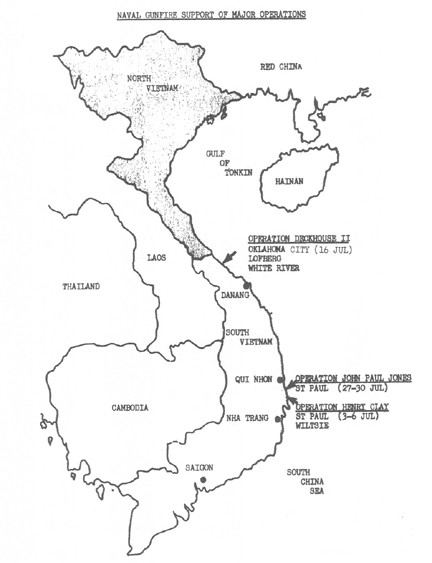
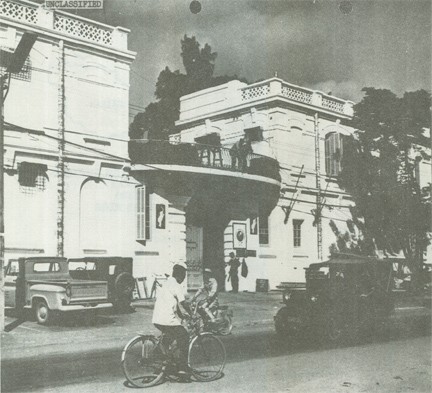
Logistics
During July, two CINCPAC ammunition transfer orders directed the transfer of 1,319 MK 84 bombs from PACFLT to PACAF and 1,456 ANM 57 bombs from PACFLT to DEPCHJUSMAGTHAI.
SEVENTH Fleet sorties averaged 1.24 tons, for a total of 7,470 tons on 6,023 attack sorties. CINCPAC requested provision in CY 67 for 1.75 tons per sortie for the Navy and 2.14 tons per sortie for the Marines.
Procedures were established during July for accelerating delivery of selected air munitions through October 1966. Navy items included MK 81 and MK 82 bombs, MK 24 flares, 2.75" and 5" ZUNI rockets, 20mm ammunition for the MK 12 gun, and MK 77 fire bombs.
Flag Pole items for July were: shortages of UH-1E aircraft and 5" AAC/HC gun ammunition. The shortage in survival radios that existed for several months was corrected by the end of July.
Shipping requirements for PACOM continued to rise during the month. In early July, 238,675 measurement tons of cargo were unbooked CONUS-wide. By the end of July, this figure was 207,493 M/T. Sea lift was expected to be increased by early August with ships from the National Defense Reserve Fleet.
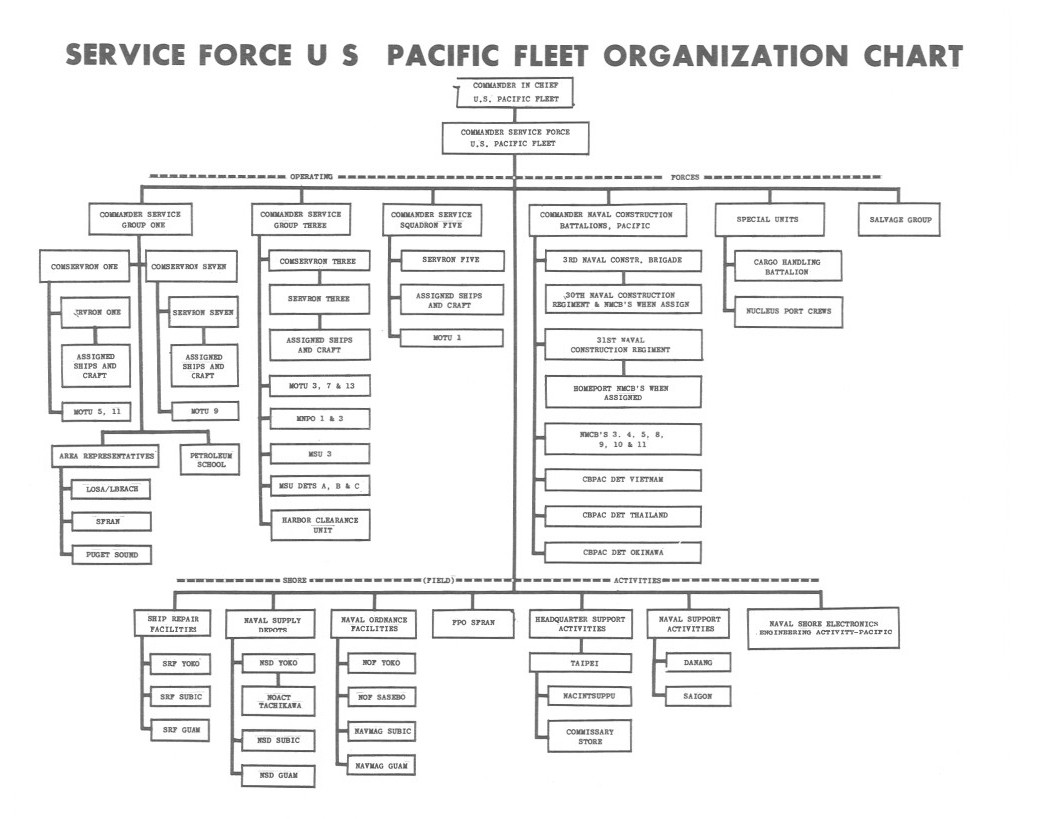
COMSTS continued efforts to charter two additional R-2 reefers for use in Republic of Vietnam service.
COMNAVSUPPACT Danang furnished approximately 100 personnel and lighterage for temporary duty to help reduce the shipping backlog at Cam Ranh Bay.
In June the water available from the Monkey Mountain, South Vietnam, source for the forces afloat, was significantly reduced. On 7 July, CINCPACFLT directed that Sasebo based YW128 be transferred temporarily with crew to the custody of NAVSUPPACT Danang. YW 128 arrived on 30 July and appreciably relieved the critical situation.
NSA Danang was selected to receive the annual National Defense Transportation Association Award for a military unit performing transportation functions under combat conditions.
Aircraft readiness statistics for SEVENTH Fleet/First Marine Aircraft Wing aircraft for the period 1-10 July 1966 were as follows:
ACFT TYPE |
PERCENT ACFT |
PERCENT NORS |
PERCENT NORM |
| A-1 | 12.5 |
3.2 |
14.9 |
| A-3 | 0.0 |
5.9 |
18.8 |
| A-4C | 36.2 |
9.7 |
17.4 |
| A-4E | 29.8 |
18.3 |
12.6 |
| F-4B | 31.8 |
18.1 |
22.3 |
| F-8C | 7.6 |
3.9 |
7.8 |
| F-8E | 16.0 |
9.2 |
10.4 |
| A-6 | 25.0 |
21.8 |
19.5 |
(NORS - Not operationally ready, supply; NORM - Not operationally ready, maintenance.)
The Navy's Military Sea Transportation Service achieved a new record in support of Army, Navy, Marine, Coast Guard, and Air Force operations. During July MSTS lifted 13,583 troops to and within Vietnam. Two transports, USNS PATCH (TAP 122) and USNS DARBY (TAP 127) accomplished the longest point-to-point troop lift in the history of MSTS by transporting over 3,000 troops of the 196th Light Infantry Brigade from Boston, via the Panama Canal, to Vung Tau. The cargo lift to and within Vietnam reached a high mark of 887,000 measurement tons. Handling of this cargo demanded 43 percent of the total MSTS world-wide effort and represents a tenfold increase over the lift handled eighteen months ago.
A SATS crosswind runway, 4,148 feet in length, was approved for Chu Lai. Delivery of 80,640 square yards of AM-2 aluminum plank airfield matting was made in early July. An additional 16,000 square yards has been requested. This quantity of matting will also provide overruns and blast pavement for the existing runway. Seven NMCB's were deployed in South Vietnam during July. The average strength of each battalion was 797 men. RVN projects in July were completed at Danang, Chu Lai, and Hue/Phu Bai.
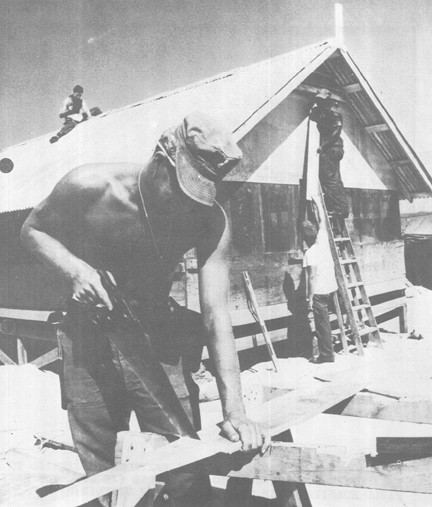
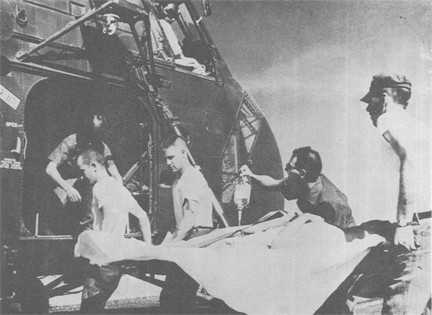
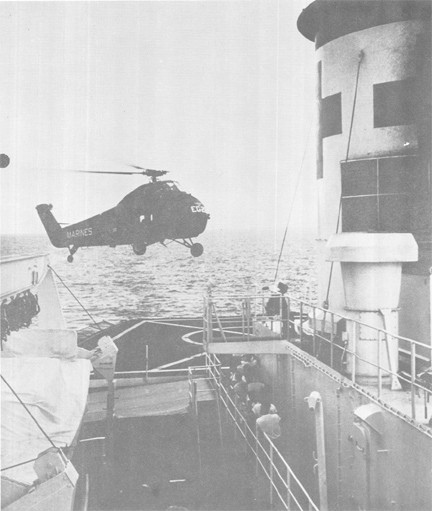
The Station Hospital, Danang, increased the number of beds to 404 in mid-July. Only the roads, helo pad, and preventive medical building were yet to be finished.
USS REPOSE returned to the line in mid-July, following about one month at SRF Yokosuka for overhaul of feed pumps. She departed Yokosuka with 48 patients, received 90 the first day on the line, and by 31 July had 328 patients on board.
Sixteen additional PCFs arrived in country during July, bringing the total number of SWIFTS there to 70. Three boats went to PCF Division 101 at An Thoi to bring that total to ten; five went to Division 102 at Danang for a total of seventeen; five to Division 103 at Cat Lo for seventeen; and three to Division 104 at Cam Ranh Bay for sixteen. No units, however, were added to Division 105 at Qui Nhon, and that total remained at ten.
During July the PACVs were engaged in installation and evaluation of various modifications to make them more suitable for operations in South Vietnam. These modifications included: twin .50 caliber machine gun mounts to replace the present single .50 caliber mount; M-60 machine gun mounts in the side windows and a remote controlled M-60 machine gun firing aft; redesigned venturi and spray shields to increase underway visibility; and installation of a rubber dam to allow the opening of the forward door while underway.
USS FLOYD COUNTY (LSD 762), assigned as Ca Mau Peninsula support vessel for PCFs and WPBs, continued operations in Areas Seven and Eight. The ability to operate PCFs from a support ship in high infiltration areas has enhanced the coastal surveillance effort.
During June and July WPBs in Coast Guard Divisions 11 and 12 underwent annual drydockings for hull renovation and painting at Bangkok and Danang respectively.
Harbor defense forces were increased during July and started limited operations. Full operations were anticipated by the end of August with the arrival of more boats and crews. Harbor Defense at Qui Nhon became fully operational on 7 July with the delivery of three LCPL MK XI patrol boats.
In aerial surveillance, Patrol Squadron TWO, operating seven SP-2H aircraft from Tan Son Nhut Airbase, continued to support MARKET TIME operations. USS SALISBURY SOUND (AV 13) established a seadrome at Cam Ranh Bay on 11 July, and conducted operations for the remainder of the month. SP-5 aircraft of Patrol Squadrons 40 and 48 flew surveillance flights out of Cam Ranh Bay, and Patrol Squadrons 47, 48 and 49 also supported operations, flying P3A aircraft out of Sangley Point.
All flew adjusted tracks during July, placing the patrol line further at sea.
Typical of the overall MARKET TIME activities in July were the following incidents:
a. On 5 July, PCF 60 witnessed a junk evading to the beach near Song Cau village after ignoring warning shots and sirens. The junk subsequently beached and the occupants fled ashore. PCF 60 destroyed the abandoned junk with mortar fire.
b. Also on 5 July, MARKET TIME units detained a total of 20 suspects including 18 without identification papers, one draft dodger and one ARVN unauthorized absentee. All were turned over to the nearest surveillance centers or other authorities.
c. On 6 July, PCF 47 received recoilless rifle fire in the vicinity of Vung Hon Khoi. PCF 47 replied with 81mm mortar fire and cleared the area.
Task Force 115 basic units consisted of 70 PCFs and 26 WPBs. The following Pacific Fleet units also operated under the operational control of Commander Task Force 115 during July:
USB NEWELL (DER 322) |
USS WOODPECKER (MSC 209) |
JULY 1966 MARKET TIME STATISTICAL SUMMARY
Average number of U.S. ships/craft on patrol during the month:
DER |
MSO |
MSC |
WPB |
PCF |
LST |
|
| TOTAL | 161 |
149 |
93 |
484 |
871 |
31 |
| DAILY AVG | 5 |
5 |
3 |
16 |
28 |
1 |
Average number of VNN ships/junks on patrol during the month:
SEA FORCE |
RIVER FORCE |
COASTAL FORCE |
|
| TOTAL | 620 |
2762 |
4714 |
| DAILY AVG | 20 |
89 |
152 |
U.S. Activity:
TOTAL DETECTED |
WOOD - STEEL - |
DAY |
55,644 |
NIGHT |
64,215 |
TOTAL INSPECTED |
WOOD - STEEL - |
DAY |
14,117 |
NIGHT |
17,789 |
TOTAL BOARDED |
WOOD - STEEL - |
DAY |
11,606 |
NIGHT |
7,987 |
| U.S. DETAINED | 1,096 persons | ||||
| 123 junks | |||||
VNN Activity:
| SEARCHED: | 23,800 junks |
| DETAINED: . |
681 persons 8 junks |
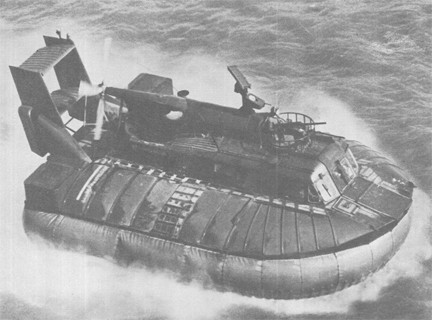

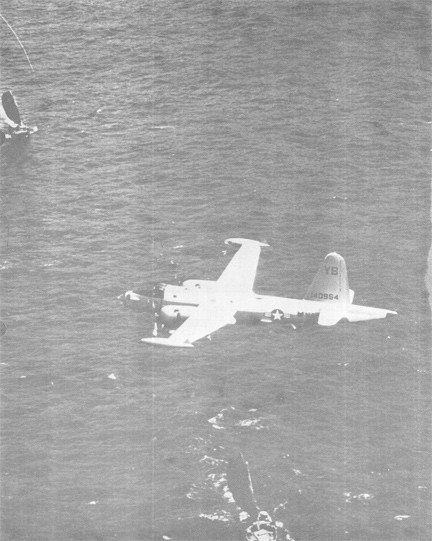
The focus of in-country naval action shifted to Operation GAME WARDEN during July as the PBRs increasingly deterred Viet Cong waterborne movement. Helicopter fire teams were also effective, both in support of the PBRs and in independent strikes on Viet Cong units. The SEAL Team, operating in the Rung Sat Special Zone, conducted its most successful operations to date. Eight additional PBRs were added to GAME WARDEN forces during the month.
A statistical summary of GAME WARDEN is as follows:
PBR Statistics:
| Total Patrols (two boats): | Day 321 | Night 461 |
| Total Contacts: | Day 17,739 | Night 3,065 |
| Total Inspected: | Day 3,994 | Night 603 |
| Total Boarded: | Day 4,686 | Night 841 |
| Persons Detained: | 899 | |
| Total Patrol Hours: | 15,414 | |
| Total Possible Patrols: | 1,953 |
| Total Patrols: | 1,564 |
| Usage: | 80+% |
Helo Fire Team Statistics:
| Structures: | Destroyed 28 | Damaged 101 |
| Sampans: | Destroyed 13 | Damaged 59 |
| Total Flight Hours: | 212 |
Helo Missions Supported:
17 reaction support of the river patrol
43 armed reconnaissance
31 logistic
2 medical evacuations
SEAL Team Statistics:
| Structures: | Destroyed 8 | Damaged 0 |
GAME WARDEN Totals:
| Structures: | Destroyed 36 | Damaged 101 |
| Sampans: | Destroyed 26 | Damaged 61 |
| Enemy KIA: | BC 18 |
EST 38 |
WIA 2 |
| Friendly KIA: | KIA 0 |
WIA 3 |
|
PBRs played an unusual role on 29 July when they provided emergency transportation for U.S. Ambassador Henry Cabot Lodge, and RADM N. Go WARD, COMNAVFORV, after their helicopter had been forced down by monsoon rains at VNN Coastal Group 35 Base. The Ambassador and his party had just completed a visit to USS TORTUGA (LSD 26) for a briefing of her role in GAME WARDEN. After receiving a message that the party was down, TORTUGA dispatched a PBR patrol to return them to the ship. They remained on board overnight and were transported to Saigon the following morning by the helicopter fire team. Operating from USS TORTUGA (LSD 26) off the mouths of the Bassac and Co Chien Rivers, the helicopter fire teams logged an impressive number of successful strikes at Viet Cong boats and facilities during July. The majority of these strikes were in the area of Long Toan and Thanh Phong Secret Zones, known Viet Cong strongholds and staging areas. At 1820, 4 July, a helicopter fire team took a large number of sampans under fire in the Long Toan Secret Zone. One sampan disintegratedin a secondaryexplosion. Six others were damaged, while a number of additional sampans took cover under foliage. During the action three PBRs were set as a blocking force in the Co Chien River estuary in the event the Viet Cong attempted to cross.
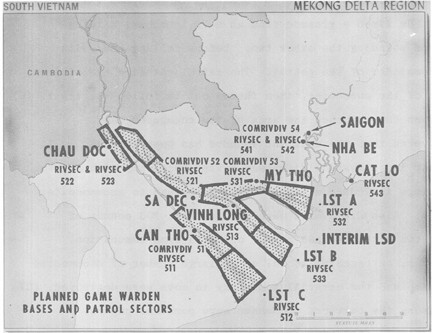
In the largest SEAL Team operation yet in the Rung Sat Special Zone, three teams, each composed of six men, were inserted by LCM 6 on 27 July at 1245 into the area west of Can Gio Village. At 1528 the point man of a team investigating a well concealed trail leading through dense mangroves came face to face with three armed Viet Congo He fired a grenade from an M-79 launcher, killing one and wounding the other two, before falling back with the remainder of the patrol. The patrol notified the other teams of the encounter, then fanned out to follow the trail.
When they reached the area of the encounter they discovered that the dead and wounded had been removed. Further investigation disclosed a Viet Cong camp with eight buildings including a mess hall large enough to accommodate 80 men. Also discovered were two sampans, 200 pounds of rice, two carbines, 500 rounds of small arms ammunition, uniforms, entrenching tools, and a large number of documents. The camp and the material too bulky to move were destroyed.
Among the captured documents were personal papers, certificates of achievement for Viet Cong, maps, training manuals, pictures and personnel rosters. Documents indicated that the camp had contained one platoon of 24 men. The maps provided defense and mine field plans for the Long Thanh Peninsula area between Can Gio and Dong Hoa.
Intelligence indicated that GAME WARDEN operations to date had significantly hampered VC efforts. Tax stations were eliminated, resupply hindered, and river crossings of up to company size interdicted. In some areas of the delta in which GAME WARDEN forces were operating, Vietnamese watermen stated they could now move on rivers in comparative safety for the first time in years.
In an attempt to establish and maintain good relationships with Vietnamese civilians exposed to PBR boarding and searching, signs in Vietnamese were prepared and distributed to the PBR units for display on the boats. These signs explain to indigenous personnel the reasons for the presence of the PBRs in their respective areas.
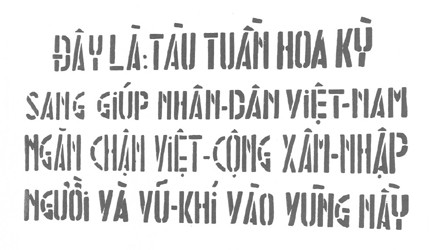
During July U.S. Navy advisors reported that the overall ability of the Vietnamese Navy to accomplish its mission remained satisfactory. New commanding officers assigned to some ships of the Fleet Command were proving to be aggressive and responsive to advice. Particularly noteworthy were improvements in the operations and maintenance of several PGMs. During July no further progress took place in the reorganization of the Vietnamese Navy.
Vietnamese Navy Coastal Groups participated in both blocking operations and amphibious landings during July. For example, in the First Coastal Zone on 2 July, Coastal Group 11 and LSSL 228 participated in Operation HO DAC HANH. While providing a blocking force they checked 37 junks and 180 people. In a significant land operation on 23 July, a Coastal Group 13 patrol made contact with an undetermined number of Viet Cong in the vicinity of Vinh Giang Village, and a 30 minute firefight ensued. Six Coastal Group sailors and three Viet Cong were killed. The Coastal Group unit captured two carbines, two sub-machine guns, 12 magazines, ammunition and grenades, indicating that more Viet Cong had been killed but carried away. In another ground action on 27 July, two platoons from Coastal Group 11 landed near the village of Xam Sao to aid 20 popular force troops under attack by a Viet Cong company.
Fleet Command PCs and PCEs continued to be utilized for coastal patrol gunfire support and limited logistic operations in all four Coastal Zones. The PGMs were utilized primarily for coastal patrol. One PGM was continually assigned to the Rung Sat Special Zone for patrol, escort services for merchant shipping and gunfire support missions. In addition to regular patrol duties, one PGM provided escort services for a hydrographic survey conducted in the Fourth Coastal Zone.
LSILs and LSSLs of the Fleet Command were used for patrol in the Rung Sat Special Zone and the Fourth Riverine Area as well as for coastal patrols in all four Coastal Zones. MSCs continued to perform coastal patrol missions as no effort was made to re-establish their minesweeping capability.
Working in conjunction with U.S. Navy MSBs, VNN MLMSs continued to maintain a daily sweep of the Long Tau River from Nha Be to Can Gio, utilizing six craft on even numbered days and four craft on odd numbered days. Advisory effort was being exerted to increase the number of craft utilized to six each day, providing three teams of two MLMSs.
River Assault Group units in the Third and Fourth Riverine Areas and the Rung Sat Special Zone were used aggressively during July although less extensively than in the previous month. Increased use of helicopters accounted for part of the usage drop. Three operations were logged by RAG 22 in the Rung Sat Special Zone. In the most significant, Operation RUNG SAT 24/66 on 12 July, three enemy base camps with supplies were located and destroyed, and one junk was captured.
LDNN (UDT) conducted only one operation during July -- a beach survey north of Qui Nhon. Four LDNN personnel continued to dive nightly in the Saigon port area to make bottom checks of the ships.
During the month four River Assault and Coastal Group craft were lost in action and one in a fire. Vietnamese Navy forces sank five Viet Cong boats, captured seven and participated in operations accounting for 247 Viet Cong killed and 39 wounded.
Maintenance practices in the Fleet Command improved during July as some new commanding officers displayed a marked concern for their hitherto neglected equipment. For example, on 21 July, PGM 601's engineering personnel worked throughout the night to replace a main engine camshaft. Timely completion of repairs without resorting to the shipyard enabled PGM 601 to make her patrol with all major equipment operational. LST 500, during an inport period completed an overhaul of one main engine using only ship's force.
A logistic lift conference was held on 25 July with Vietnamese Army and Navy officers and advisors participating. It was decided that scheduling of logistics lifts was to be done by the VNN after receipt of cargo from the Army. During July the amount of cargo carried by VNN logistic lift ships doubled that carried in June. .The number of troops carried remained the same. Utilization of the logistic lift ships is still hindered b} limited docking space which must be shared with U.S., Australian and Korean ships.
During July, units of the Vietnamese Marine Corps were employed in a variety of roles, both political and military . In all cases the units concerned exhibited a high degree of loyalty and esprit. Unit morale remained high and the caliber of NOD leadership continued to improve. Officers of the VNMC displayed a high degree of leadership on numerous occasions during the month.
Task Force Alpha of the Vietnamese Marine Corps performed a civil disorder mission in Danang until 23 July, when the Task Force returned to Saigon. On 28 July they provided security for the dedication of the new National Cemetery.
Task Force Bravo departed Saigon on 14 July for Hue - Phu Bai, and upon arrival assumed operational control of the Third Vietnamese Marine Battalion at Danang. Until 24 July, the Task Force was Corps Reserve for Operation HASTINGS but was not committed. On 24 and 25 July the Fourth Battalion participated in Operation LAM SON 291 and was ambushed by a company sized Viet Cong Force. Under mortar and small arms fire, however, the Battalion deployed and forced the Viet Cong to withdraw. Four Viet Cong were killed and three were wounded.
On 29 July, the entire Task Force Bravo commenced Operation LAM SON 289A, a search and clear operation along the southern edge of the Demilitarized Zone. The operation was terminated on 31 July.

The most delicate of the recent problem areas was resolved on 9 July, when the case of the five generals responsible for the country's recent political disturbances was judged by a special military council of twenty generals. In addition to 60 days confinement for each, all were either discharged or retired from the army, including LTGEN Nguyen Chanh THI, the instigator and politically powerful leader of the movement. The religious discord was also quieted when Tam CHAU, powerful leader of the Buddhist Institute, signed a compromise agreement with the Government on 3 July. With the settlement of these two problem areas, the scene was then set for electoral preparations.
The information ministry developed a four-phase program designed to encourage popular voting in the 11 September elections. Phase I included dissemination of election decrees and explanations of the purpose and importance of the elections. The other phases provided for reporting of the election results and emphasized the democracy of voting.
According to interrogation reports and captured enemy documents, more attacks were ordered on U.S. and ARVN airfields in apparent retaliation for the bombing of the Hanoi and Haiphong POL facilities.
The addition of the 324B division in northern Quang Tri province raised the total North Vietnamese Army in-country strength to 41,360, with 34,795 of these having infiltrated this year. In addition, as many as 42,000 North Vietnamese troops were estimated to be stationed in Laos, 17,000 of whom were regulars.
NORTH VIETNAM
On the afternoon of 1 July, three North Vietnamese PT boats launched torpedoes (from a distance of 10 miles) against three U.S. SAR destroyers while rapidly closing the position of the destroyers. In the ensuing minutes, reacting air strikes sank all three of the PTs before any damage could be inflicted on the destroyers; and 19 survivors were taken captive. It was later learned from the captives that the 65 foot boats had deployed from the port of "Hangai" and that the attack had been ordered by the Military High Command at Hanoi in retaliation for the POL strikes on Hanoi and Haiphong. Mounting frustration within the North Vietnamese Navy and the consequent need for a military and political victory by this relatively unengaged service were also reasons advanced for the attempted raid.
The effects of the POL strikes on North Vietnam's seaborne imports were becoming obvious. During the month, 26 foreign ships called at North Vietnamese ports, but there were no tankers among them. From the 13 Soviet cargo ships that did arrive, North Vietnam received over 61,000 tons of general cargo, in addition to 947 tons of POL which was shipped in drums and therefore not dependent upon the destroyed storage tanks. Two Soviet tankers scheduled to arrive at North Vietnam with an additional 13,900 tons of bulk POL were diverted to Communist China, one arriving at Chan Chiang on 5 July, the other arriving at Shanghai on 21 July. Overall, the rate of foreign ship arrivals during the first half of 1966 dropped 32 percent compared to the same period in 1965 -- from 300 to 206. However, the volume of cargo dipped by only 10 percent because the USSR began using larger ships.
If tanker diversion to CHICOM ports is forced to continue, several transshipment alternatives exist. It is estimated that North Vietnamese POL import requirements at the current rate of economic and military activity are 15,000 to 20,000 tons a month. In view of the vulnerability of North Vietnamese LOCs, the easiest way to transship POL requirements of this magnitude from South China's ports would be by coastal freighter or junks, which are in sufficient supply. Transshipment to North Vietnam from Shanghai, however, would probably be attempted by rail. It is estimated that 170 tank cars, about one percent of China's inventory, would be needed in continuous service to transport North Vietnam's monthly needs in this manner.
One of the problems incident to POL transshipment by rail is the gauge disparity between North Vietnam and China. To compensate for this handicap, some effort toward a dual gauge system has been detected in the past.
In the offensive air war in North Vietnam, dispersion seemed to be the watchword this month. The NVN air order of battle, which had numbered 108 MIGs in photography of 3 March 1966, showed a 40 percent reduction in the most recent shots of the four NVN airfields used for intercept activity. It was therefore suspected that NVN had deployed an unknown number of interceptor aircraft to China. Meanwhile, SAM construction increased substantially with 11 new sites discovered this month. This raised to 124 the number of locations for surface-to-air missile battalions in-country.
As a further defense against air strikes, there was evidence this month of possible conversion to an integrated air/SAM zone defense system covering an area north of 21 (o) N latitude and east of the Lao Kay railroad. The MIG area of operation within this system appeared to be limited to a 60 mile radius of Phuc Yen airfield. Additionally, there was evidence that low altitude (3000' - 6500') tactics will probably be used when North Vietnamese aircraft are committed to intercepting incoming strikes.
In other developments, the fate of captured U.S. pilots appeared to have been favorably resolved this month. Concern was heightened on 10 July when Hanoi presented a legal justification for their trial as war criminals based on the Nuremburg tribunals and Genocide Convention as well as on domestic North Vietnamese law. On 23 July, however, Hanoi, probably feeling its recent propaganda threats to be counter-productive, announced the formation of a largely civilian investigative committee.
COMMUNIST CHINA
New information received this month indicated that the "cultural revolution" was continuing in full swing. In a I July editorial marking the 45th anniversary of the CHICOM Party, Peiping described the recent political turmoil as an attempted "counterrevolutionary coup" which had been thoroughly crushed. It accused recent plotters of attempting to seize power in the party, army and government with the aim of restoring capitalism.
Civic Action and Psychological Operations
In Danang a "lite-a-bike" safety campaign to reduce night accidents was established with the cooperation of the Danang Chief of Police. A red reflective tape was placed on the rear fender and white tape on the front of all bicycles and motorcycles to help prevent night accidents.
NAVSUPPACT Danang has organized three man Village Action Teams to aid villagers in the area. In Truyen Tia Hamlet one team worked with the villagers in building five homes, replacing a well casing and installing a culvert.
Within the Third Coastal Zone the most successful program continued to be Medical Civic Action (MEDCAP). The success of the program is attributed to fine cooperation between U.S. Navy advisors and their Vietnamese Navy counterparts and U.S. Army doctors, nurses and helicopter pilots. Transportation for the MEDCAP teams and their supplies is provided by Vietnamese Navy Coastal Force junks or Army helicopters to coastal villages throughout the Third Coastal Zone.
In other civic action, 100 tons of coal were moved by Navy personnel from Danang to Hue to enable lime kiln operators to continue production. During July, U.S. Navy and Coast Guard units on patrol assisted 16 disabled junks. The Vietnamese Navy Hospital Ship (LSMH 400) deployed to the First Coastal Zone, and outfitting was started on a second hospital ship.
Other civic action projects for July may be summarized as follows:
Construction projects:
a. |
Churches, Temples/Pagodas |
1 Repair (R) |
b. |
Culverts |
3 |
c. |
(1) Dwellings |
5 |
d. |
Hospitals |
1 (R) |
e. |
Orphanages |
1 (R) |
f. |
(1) Schools, Public |
3 (1-R) |
g. |
Parks |
1 (R) |
Medical Treatments:
a. |
General Medical |
14,742 |
b. |
Dental |
932 |
c. |
Surgery |
17 |
d. |
Emergency Evacuations |
10 |
e. |
Hairlip Operations |
6 |
Health and Sanitation:
a. |
Physical Examination |
383 |
b. |
Spray Insecticide Operations |
1 |
Distribution of commodities (pounds unless otherwise specified):
a. |
Cement |
63,100 |
b. |
Clothing |
5,730 |
c. |
Fertilizer |
300 |
d. |
Food |
70,363 |
e. |
Lumber (Board Feet) |
29,800 |
f. |
Medical, Non-Prescription |
652 |
g. |
School Kits (Number) |
732 |
h. |
Soap |
4,874 |
i. |
Tin Sheets (Number) |
55 |
j. |
Family Kits (Number) |
1,150 |
k. |
Textile Kits (Number) |
1,125 |
l. |
Washbucket Kits (Number) |
2,895 |
m. |
Sewing Kits (Number) |
700 |
n. |
Concertina Wire (Rolls) |
29 |
o. |
Toys |
200 |
p. |
Magazines (Number) |
3,820 |
Education Efforts:
a. |
(1) English Classes |
41 |
Voluntary contributions in support of: (Piasters)
a. |
Orphanages |
25,000 |
b. |
Schools |
2,360 |
c. |
Medical Operations |
4,520 |
d. |
Individuals and/or Families |
8,080 |
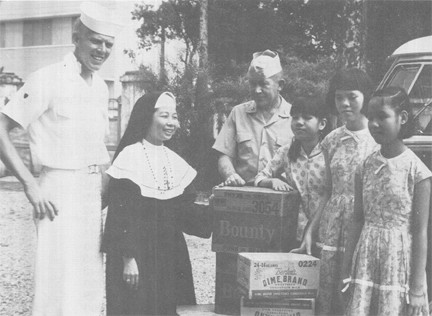
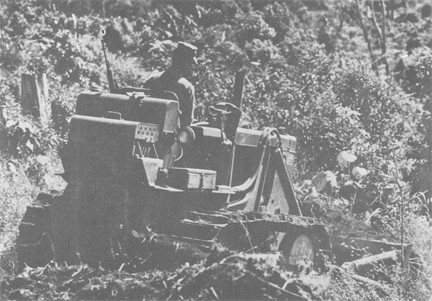
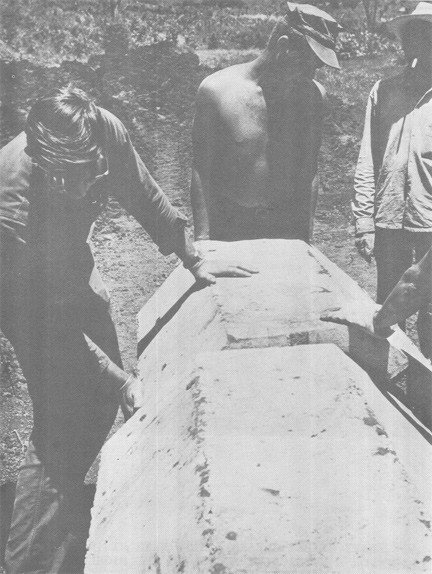
Marines
Eight operations of battalion size or larger were conducted in July, resulting in a confirmed total of 1,039 enemy regulars killed, 22 captured and 253 weapons seized. Field commanders estimated the real total to be much higher with the bulk of the enemy killed in Operation HASTINGS.
There were more than 12,000 counterguerrilla operations during the month which was the third highest monthly total of the war. More important, however, was the fact that there were more contacts and more guerrilla enemy killed than in any previous month.
Fixed wing aircraft flew more than 5,000 combat or combat support sorties, mostly in support of the III MAF. Armed helos flew more than.40,000 sorties, which was a new record.
Finally, there were 20 County Fair operations during the month, compared with seven in June. The 48 County Fairs to date have screened, fingerprinted, interviewed, photographed and provided medical treatment to about 21,000 civilians.
From CINCPACFLT:
The performance of IFS/LSMR during three months on the line in support of ground forces in RVN has justified their reactivation. These ships have demonstrated a point target capability approaching DD/CA in accuracy in addition to their inherent ability to neutralize an area. The major advantages of these ships have been:
- Greater cost effectiveness, when compared with using a destroyer for the same services.
- Shallow draft, permitting employment in areas not otherwise accessible to other NGFS ships.
- Large ammunition capacity, permitting reasonable on station periods without resupply.
Limiting factors in the employment of these craft have been:
- Short range of the five-inch spin-stabilized rockets, limiting the depth of available support. (This is somewhat alleviated by the ability to operate closeinshore.)
- Slow speed increases transit times and reduces responsiveness to non-scheduled missions.
- Vulnerability to counter-battery and small arms fire.
- Lack of underway replenishment capability.
The reactivation of additional LSMRs would be a relatively inexpensive means of further increasing NGFS capability. The value of these units in support of other contingency plans for WESTPAC is also worthy of consideration in future planning.
From CINCPACAF:
MIG TACTICS IN NORTH VIETNAM
Hi-Lo Pairs: Four aircraft in what could be called a formation of two elements of two aircraft each. The lead (Hi) pair usually first appears between 5000 and 6500 feet altitude and between four and eight o'clock relative to the target aircraft. The second (Lo) pair is usually sighted at 1500 - 3000 feet, slightly behind with a mile separation from the lead element.
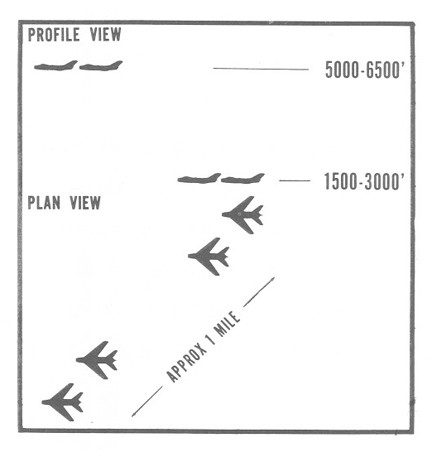
The lead element is apparently moving through its initial position enroute to a position aft and slightly above target aircraft. From this position he launches his attack. Attack is by single aircraft in diving passes, each attacker taking one target aircraft (i.e., MIG 1 on Target 1, and MIG 2 on Target 2).
The Lo pair maneuver so as to be in position to attack target aircraft when the evasive maneuver is begun. The MIG separation maintained prior to the target's evasive maneuver places the MIG in position to press the attack irrespective of the direction of the evasive turn. The attack is on a one-for-one basis.
Stacked Three: This is a very loose formation of three aircraft, and is called a formation only because the same spacing arrangement has appeared repeatedly. In American terminology, it would more appropriately be called a gaggle of aircraft.
The lead aircraft will first appear at 6500 - 8000 feet altitude, aft of the target aircraft. The second MIG will be at 1500 - 3000 feet and echeloned approximately 40 degrees and one mile off the lead MIG. The third MIG will be at an intermediate altitude, approximately 5000 feet, aligned aft of the lead MIG and echeloned 40 degrees and one mile off MIG #2.
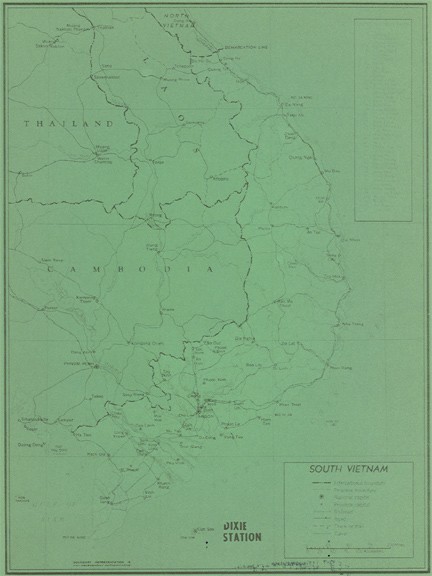
This document is part of the Vietnam Command Files, Operational Archives Branch, Naval Historical Center, Washington, D.C.


